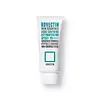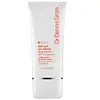What's inside
What's inside
 Key Ingredients
Key Ingredients

 Benefits
Benefits

 Concerns
Concerns

 Ingredients Side-by-side
Ingredients Side-by-side

Water
Skin ConditioningCyclohexasiloxane
EmollientZinc Oxide
Cosmetic ColorantCI 77891
Cosmetic ColorantPropanediol
SolventPolyglyceryl-3 Polydimethylsiloxyethyl Dimethicone
Skin ConditioningDibutyl Adipate
EmollientNiacinamide
SmoothingCaprylyl Methicone
Skin Conditioning1,2-Hexanediol
Skin ConditioningDisteardimonium Hectorite
StabilisingSorbitan Sesquioleate
EmulsifyingMagnesium Sulfate
Hydrogen Dimethicone
Trehalose
HumectantAluminum Hydroxide
EmollientC30-45 Alkyl Cetearyl Dimethicone Crosspolymer
EmollientStearic Acid
CleansingPrunus Amygdalus Amara Kernel Oil
MaskingCamellia Sinensis Leaf Extract
AntimicrobialEthylhexylglycerin
Skin ConditioningPyrus Malus Leaf Extract
Skin ConditioningOctyldodecanol
EmollientAdenosine
Skin ConditioningVanilla Planifolia Fruit Extract
Skin ConditioningJasminum Officinale Flower Extract
MaskingEchium Plantagineum Seed Oil
Skin ConditioningSalvia Hispanica Seed Extract
EmollientCentella Asiatica Extract
CleansingHouttuynia Cordata Extract
Skin ConditioningFructooligosaccharides
HumectantSaccharide Hydrolysate
HumectantPullulan
Cardiospermum Halicacabum Flower/Leaf/Vine Extract
Skin ConditioningHelianthus Annuus Seed Oil Unsaponifiables
EmollientBiosaccharide Gum-4
Skin ConditioningPolyglyceryl-2 Dipolyhydroxystearate
Skin ConditioningUndecane
EmollientTridecane
PerfumingTocopherol
AntioxidantHelianthus Annuus Seed Oil
EmollientWater, Cyclohexasiloxane, Zinc Oxide, CI 77891, Propanediol, Polyglyceryl-3 Polydimethylsiloxyethyl Dimethicone, Dibutyl Adipate, Niacinamide, Caprylyl Methicone, 1,2-Hexanediol, Disteardimonium Hectorite, Sorbitan Sesquioleate, Magnesium Sulfate, Hydrogen Dimethicone, Trehalose, Aluminum Hydroxide, C30-45 Alkyl Cetearyl Dimethicone Crosspolymer, Stearic Acid, Prunus Amygdalus Amara Kernel Oil, Camellia Sinensis Leaf Extract, Ethylhexylglycerin, Pyrus Malus Leaf Extract, Octyldodecanol, Adenosine, Vanilla Planifolia Fruit Extract, Jasminum Officinale Flower Extract, Echium Plantagineum Seed Oil, Salvia Hispanica Seed Extract, Centella Asiatica Extract, Houttuynia Cordata Extract, Fructooligosaccharides, Saccharide Hydrolysate, Pullulan, Cardiospermum Halicacabum Flower/Leaf/Vine Extract, Helianthus Annuus Seed Oil Unsaponifiables, Biosaccharide Gum-4, Polyglyceryl-2 Dipolyhydroxystearate, Undecane, Tridecane, Tocopherol, Helianthus Annuus Seed Oil
Titanium Dioxide
Cosmetic ColorantZinc Oxide
Cosmetic ColorantAcrylates/Carbamate Copolymer
Skin ConditioningAluminum Hydroxide
EmollientAscorbyl Glucoside
AntioxidantBenzyl Alcohol
PerfumingBHT
AntioxidantBis-Ethylhexyl Hydroxydimethoxy Benzylmalonate
AntioxidantBoerhavia Diffusa Root Extract
Skin ProtectingButylene Glycol
HumectantC12-15 Alkyl Benzoate
AntimicrobialCaprylyl Glycol
EmollientCarbomer
Emulsion StabilisingCarthamus Tinctorius Seed Oil
MaskingCitric Acid
BufferingCitrus Aurantium Dulcis Oil
MaskingCitrus Aurantium Dulcis Peel Extract
Emulsion StabilisingCoco-Caprylate/Caprate
EmollientCoconut Alkanes
EmollientDisodium EDTA
Echium Plantagineum Seed Oil
Skin ConditioningGlycerin
HumectantGlycolic Acid
BufferingHydrogenated Lecithin
EmulsifyingHydroxyethyl Acrylate/Sodium Acryloyldimethyl Taurate Copolymer
Emulsion StabilisingHydroxypropyl Cyclodextrin
MaskingIsohexadecane
EmollientIsononyl Isononanoate
EmollientIsopropyl Titanium Triisostearate
EmollientMagnesium Ascorbyl Phosphate
AntioxidantMelatonin
AntioxidantNordihydroguaiaretic Acid
AntioxidantOenothera Biennis Oil
EmollientOlea Europaea Fruit Oil
MaskingOleanolic Acid
Skin ConditioningOryza Sativa Extract
AbsorbentPalmitoyl Tripeptide-38
Skin ConditioningPEG-60 Almond Glycerides
EmulsifyingPentylene Glycol
Skin ConditioningPhenoxyethanol
PreservativePhospholipids
Skin ConditioningPolyhydroxystearic Acid
EmulsifyingPolysorbate 60
EmulsifyingPotassium Sorbate
PreservativePropanediol
SolventSaccharide Isomerate
HumectantSodium Benzoate
MaskingSodium Citrate
BufferingSodium Hyaluronate
HumectantSodium PCA
HumectantSphingolipids
EmollientStearic Acid
CleansingTetrahexyldecyl Ascorbate
AntioxidantTocopherol
AntioxidantWater
Skin ConditioningXanthan Gum
EmulsifyingZinc PCA
HumectantTitanium Dioxide, Zinc Oxide, Acrylates/Carbamate Copolymer, Aluminum Hydroxide, Ascorbyl Glucoside, Benzyl Alcohol, BHT, Bis-Ethylhexyl Hydroxydimethoxy Benzylmalonate, Boerhavia Diffusa Root Extract, Butylene Glycol, C12-15 Alkyl Benzoate, Caprylyl Glycol, Carbomer, Carthamus Tinctorius Seed Oil, Citric Acid, Citrus Aurantium Dulcis Oil, Citrus Aurantium Dulcis Peel Extract, Coco-Caprylate/Caprate, Coconut Alkanes, Disodium EDTA, Echium Plantagineum Seed Oil, Glycerin, Glycolic Acid, Hydrogenated Lecithin, Hydroxyethyl Acrylate/Sodium Acryloyldimethyl Taurate Copolymer, Hydroxypropyl Cyclodextrin, Isohexadecane, Isononyl Isononanoate, Isopropyl Titanium Triisostearate, Magnesium Ascorbyl Phosphate, Melatonin, Nordihydroguaiaretic Acid, Oenothera Biennis Oil, Olea Europaea Fruit Oil, Oleanolic Acid, Oryza Sativa Extract, Palmitoyl Tripeptide-38, PEG-60 Almond Glycerides, Pentylene Glycol, Phenoxyethanol, Phospholipids, Polyhydroxystearic Acid, Polysorbate 60, Potassium Sorbate, Propanediol, Saccharide Isomerate, Sodium Benzoate, Sodium Citrate, Sodium Hyaluronate, Sodium PCA, Sphingolipids, Stearic Acid, Tetrahexyldecyl Ascorbate, Tocopherol, Water, Xanthan Gum, Zinc PCA
 Reviews
Reviews

Ingredients Explained
These ingredients are found in both products.
Ingredients higher up in an ingredient list are typically present in a larger amount.
Aluminum Hydroxide is a form of aluminum. It can be naturally found in nature as the mineral gibbsite. In cosmetics, Aluminum Hydroxide is used as a colorant, pH adjuster, and absorbent.
As a colorant, Aluminum Hydroxide may add opacity, or reduce the transparency. Aluminum hydroxide is contains both basic and acidic properties.
According to manufacturers, this ingredient is an emollient and humectant. This means it helps hydrate the skin.
In medicine, this ingredient is used to help relieve heartburn and help heal ulcers.
There is currently no credible scientific evidence linking aluminum hydroxide in cosmetics to increased cancer risk.
Major health organizations allow the use of aluminum hydroxide in personal care products and have not flagged it as a carcinogenic risk at typical usage levels.
Learn more about Aluminum HydroxideEchium Plantagineum Seed Oil is an oil and isn't fungal acne safe.
Propanediol is an all-star ingredient. It softens, hydrates, and smooths the skin.
It’s often used to:
Propanediol is not likely to cause sensitivity and considered safe to use. It is derived from corn or petroleum with a clear color and no scent.
Learn more about PropanediolStearic Acid is a fatty acid. It is an emollient, emulsifier, and texture enhancer.
As an emollient, stearic acid helps soften skin. It aids the skin's protective barrier by preventing water loss. It also provides a gentle cleansing effect without stripping away natural oils.
Stearic acid may also be used to enhance the texture of products. It can add volume and stabilize ingredients such as water and oil. This can help water and oil ingredients from separating.
Sources of stearic acid include animal or vegetable fats/oils such as coconut or shea. It can be naturally found in butter, cocoa butter, shea butter, vegetable fats, and animal tallow.
This ingredient may not be Malassezia folliculitis, or fungal-acne safe.
Learn more about Stearic AcidTocopherol (also known as Vitamin E) is a common antioxidant used to help protect the skin from free-radicals and strengthen the skin barrier. It's also fat soluble - this means our skin is great at absorbing it.
Vitamin E also helps keep your natural skin lipids healthy. Your lipid skin barrier naturally consists of lipids, ceramides, and fatty acids. Vitamin E offers extra protection for your skin’s lipid barrier, keeping your skin healthy and nourished.
Another benefit is a bit of UV protection. Vitamin E helps reduce the damage caused by UVB rays. (It should not replace your sunscreen). Combining it with Vitamin C can decrease sunburned cells and hyperpigmentation after UV exposure.
You might have noticed Vitamin E + C often paired together. This is because it is great at stabilizing Vitamin C. Using the two together helps increase the effectiveness of both ingredients.
There are often claims that Vitamin E can reduce/prevent scarring, but these claims haven't been confirmed by scientific research.
Learn more about TocopherolWater. It's the most common cosmetic ingredient of all. You'll usually see it at the top of ingredient lists, meaning that it makes up the largest part of the product.
So why is it so popular? Water most often acts as a solvent - this means that it helps dissolve other ingredients into the formulation.
You'll also recognize water as that liquid we all need to stay alive. If you see this, drink a glass of water. Stay hydrated!
Learn more about WaterZinc Oxide is a mineral broad-spectrum UV filter; it is the broadest UVA and UVB reflector approved by the FDA. It also has skin protectant and skin soothing properties.
Zinc oxide is one of the most effective broad-spectrum UV filters. It protects against UVB, UVAII, and UVAI. In comparison to its counterpart titanium dioxide, zinc oxide provides uniform and extended UVA protection.
Another great benefit? This ingredient is highly photostable so it won't degrade easily under sunlight.
A common myth is that mineral UV filters are widely believed to primarily reflect UV light.
However, modern research shows titanium dioxide absorbs UV radiation like chemical filters (~95% absorption & 5% reflection).
Zinc oxide has great skin soothing properties so you'll likely find this in sunscreens formulated for sensitive skin or babies/children. It is unlikely to cause "eye sting" like other sunscreen ingredients.
Regulatory agencies consider zinc oxide to be non-toxic and safe. It has also been shown to not penetrate the skin.
Unfortunately, this ingredient does leave a visible white cast. This is why mineral sunscreens are often less cosmetically elegant than chemical or hybrid ones.
In cosmetics, zinc oxide can be found in both non-nano and nano-sized forms. The nano version is used to reduce white cast and improve the texture of sunscreen formulas.
There are ongoing concerns surrounding nano-zinc oxide's impact on marine ecosystems and whether it can be absorbed into skin.
Regarding marine ecosystems and coral reefs, there is no conclusive evidence that any form of zinc oxide (or any other sunscreen ingredients) will cause harm. The science is still developing but many consumers are keeping a close eye on this issue.
Please note, many destinations have reef-safety sunscreen rules. For instance, the U.S. Virgin Islands advises all visitors to use non-nano mineral sunscreens.
There has also been some stir about whether micronized or nano zinc oxide has potential photoxicity and absorption through the skin/lungs.
An in-vitro (done in a test tube or petri dish) study demonstrated micronized zinc oxide to have potential phototoxicity. There's no need to fret; the EU Commission's Scientific Committee on Consumer Safety has stated, "The relevance of these findings needs to be clarified by appropriate investigations in vivo." Or in other words, further studies done on living organisms are needed to prove this.
Current research shows zinc oxide nanoparticles do not penetrate intact or sunburned skin. They either remain on the surface or in the outermost layer of dead skin (stratum corneum).
Zinc oxide is one of only two classified mineral UV filters with titanium dioxide being the other one.
Fun fact: Zinc has been used throughout history as an ingredient in paint and medicine. An Indian text from 500BC is believed to list zinc oxide as a salve for open wound. The Ancient Greek physician Dioscorides has also mentioned the use of zinc as an ointment in 1AD.
Learn more about Zinc Oxide